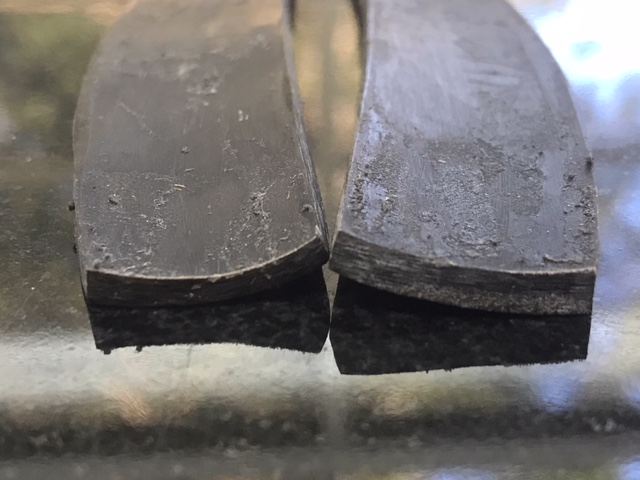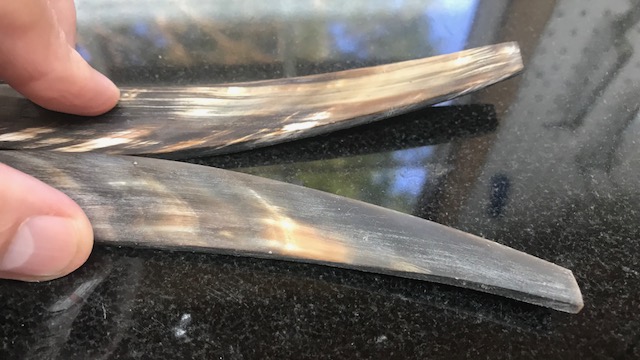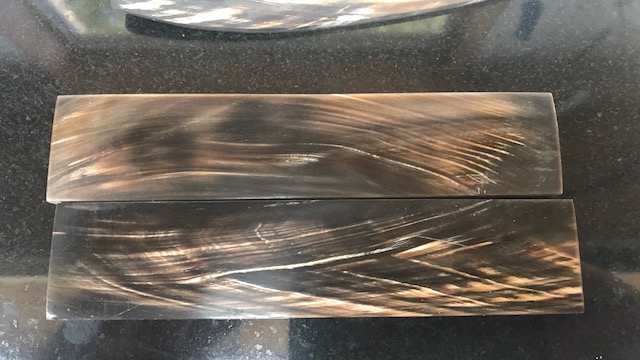Results 1 to 10 of 16
Thread: Extreme Bow/Warp in Horn Scales
-
09-08-2018, 12:45 PM #1
 Extreme Bow/Warp in Horn Scales
Extreme Bow/Warp in Horn Scales
CJ Bianco (who still occasionally drops by here) asked me to rescale an Atlas Japanese blade for him. He picked out a gorgeous set of brown feathered horn from my stash, so off I went. I cut them out, double-side taped them inside out to flatten the insides, then did the same for the outsides, doing my usual shaping and thicknessing as I go. But even though I had clamped the scales together HARD on the tape, they started to bow out before I was done-as you can see, one is still slightly thicker than the other (which would have been a quick fix if I could only get them back to flat!).

So despite repeated application of both wet and dry heat, dry ironing per Mike's suggestion, all followed by clamping between heavy DMT plates, etc., they just got even more bowed and warped/curled outward.

I hate to give up on a beautiful, one-of-a-kind set of horn scales like this, but I've hit a wall, guys-never had horn go this haywire on me that I couldn't fix (and I've worked with horn a good bit).
Plan B is another nice set from my Indian Ebay supplier here; not as nice, but I've got them if I need to start over.

I appreciate any advice from anyone who has saved a pair that is this far gone! Aaron
-
09-08-2018, 01:28 PM #2Senior Member


- Join Date
- Jun 2013
- Location
- Pompano Beach, FL
- Posts
- 4,048
Thanked: 636
Try heating them in hot water for 5-17 minutes. Place between two flat boards and clamp tight. Let cool completely. That should flaten them.
-
The Following User Says Thank You to bouschie For This Useful Post:
ScoutHikerDad (09-08-2018)
-
09-08-2018, 02:12 PM #3Senior Member




- Join Date
- Feb 2013
- Location
- Haida Gwaii, British Columbia, Canada
- Posts
- 14,457
Thanked: 4830
You can get the horn much hotter in oil than you can in water. It will allow you to flattenit but if you get the horn too hot in the oils it will become very brittle. Monitoring oil temperatures with a calibrated thermometer is important. If you get it hotter than 300 is where things go sideways. It gets quite pliable starting around 225. Heat it up and clamp it flat.
It's not what you know, it's who you take fishing!
-
The Following 2 Users Say Thank You to RezDog For This Useful Post:
MikeT (09-08-2018), ScoutHikerDad (09-08-2018)
-
09-08-2018, 03:45 PM #4

Well Aaron, when I get scales that want to return to their warped shape. I like to heat them till a very pliable state, then bend and twist them back n forth to break the memory in the fibers, then clamp them. You'll need gloves. I've had to do thus several times to a few sets to get them to hold true
Mike
-
The Following 2 Users Say Thank You to outback For This Useful Post:
MikeT (09-08-2018), ScoutHikerDad (09-08-2018)
-
09-08-2018, 03:56 PM #5

I concur with outback..Man, the hot iron Engine Steve showed us works awesome!
Outback's trick of working them back really seems to work great in conjunction.
-
The Following 2 Users Say Thank You to sharptonn For This Useful Post:
outback (09-09-2018), ScoutHikerDad (09-08-2018)
-
09-08-2018, 04:43 PM #6

Thanks for all the replies-I'll try one or a combination of them if necessary and report back, but it may be a week or so. When I clamp them this time, I think I'm going to just leave them for a few days to see if it helps break the memory.
If I can get them to work, I can tell that that set will just come alive once contoured and polished around the complementary brass hardware Bianco picked out.
-
09-08-2018, 04:51 PM #7

This breaking of the bonds that outback suggested is a great addition.
Of course I have read many times about the heating and clamping, the temp restrictions are good to keep in mind also.
One thread a while back I remember talked about not clamping them flat, but in a curve opposite and mirrored to the curve you wish to correct.
*** I have never done this, I'm simply repeating.
As with many techniques, a combination of techniques put together in the correct order seems to me to be a good concept.
Good luck with that! “You must unlearn what you have learned.”
“You must unlearn what you have learned.”
– Yoda
-
The Following User Says Thank You to MikeT For This Useful Post:
ScoutHikerDad (09-08-2018)
-
09-08-2018, 06:29 PM #8

TBH, anytime anything is bent, it usually must be somehow bent back a little past straight to get it right.
I have used toothpicks strategically placed under materials as being clamped-down to accomplish it.
-
The Following 2 Users Say Thank You to sharptonn For This Useful Post:
MikeT (09-08-2018), ScoutHikerDad (09-08-2018)
-
09-08-2018, 08:20 PM #9
 “You must unlearn what you have learned.”
“You must unlearn what you have learned.”
– Yoda
-
09-08-2018, 09:45 PM #10

You gotta wing it, MikeT! A little at a time till it works!

-
The Following User Says Thank You to sharptonn For This Useful Post:
MikeT (09-08-2018)


 32Likes
32Likes LinkBack URL
LinkBack URL About LinkBacks
About LinkBacks







 Reply With Quote
Reply With Quote
